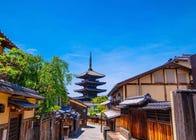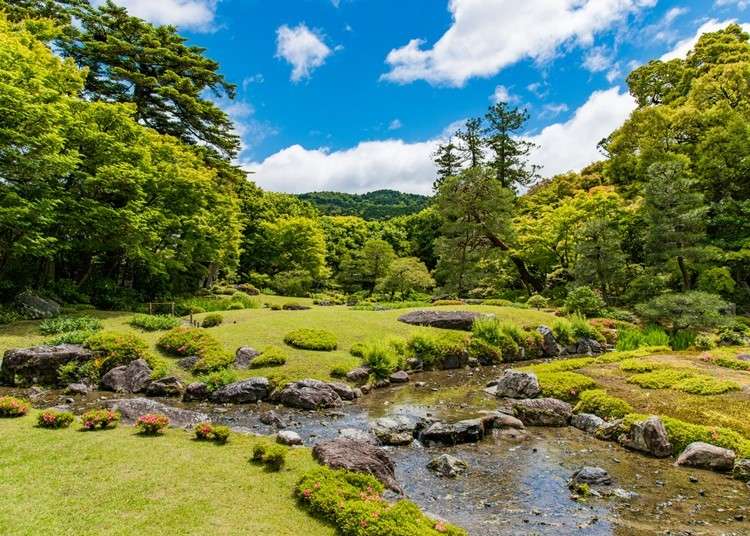
5 Traditional Japanese Gardens in Kyoto and How to Enjoy Them: Tips from A Kyoto Landscaping Firm
- Written by: WESTPLAN
There are plenty of beautiful Japanese gardens in Kyoto that are worth visiting. At a Strolling Pond Garden, you can stroll around a large pond or hop on a boat.
Karesansui, or dry landscape gardens, replicate magnificent scenery and the spirit of Zen using no water, just stones and sand. There's a mysterious charm to these Japanese gardens that has grown and captivated viewers' hearts throughout its history, and tempts one to gaze out at them forever.
Saki Yamada, director of the Heritage and Garden Artistry division of the long-established Kyoto landscaping firm Ueyakato Landscape, founded in 1848, lets us in on some secrets about Japanese gardens and shares tips on enjoying them.
Top photo: Murin-an (Photo: Ueyakato Landscape)
- Table of Contents
-
- We speak with Ueyakato Landscape, a landscaping company that develops scenic gardens
- Concept and history of Japanese gardens
- 3 Things to know about Japanese gardens
- Tips for viewing design-focused Japanese gardens
- Finding the Viewpoint: 5 Famous Kyoto Gardens
- 1. Nanzen-in: The Fresh Green Birthplace of Nanzen-ji Temple
- 2. Ryoanji: A World-Famous Japanese Dry Garden
- 3. Katsura Imperial Villa: A Collection of the Best Imperial Courts
- 4. Shosei-en: A Spacious Garden Near Kyoto Station
- 5. Murin-an: A Masterpiece of a Modern Japanese Garden
We speak with Ueyakato Landscape, a landscaping company that develops scenic gardens

We spoke with landscaping firm Ueyakato Landscape. Since its founding over 170 years ago, the company has been the exclusive gardening company for Nanzen-ji Temple and is currently involved in the cultivation and management of a number of scenic gardens designated as cultural properties.
Amongst these are Higashi Honganji Temple and Chishakuin Temple. They have also designed traditional gardens in a modern style for attractions such as the Fukuda Art Museum and Hoshino Resorts, as well as overseas in Vancouver, Dubai, and Singapore.
Concept and history of Japanese gardens
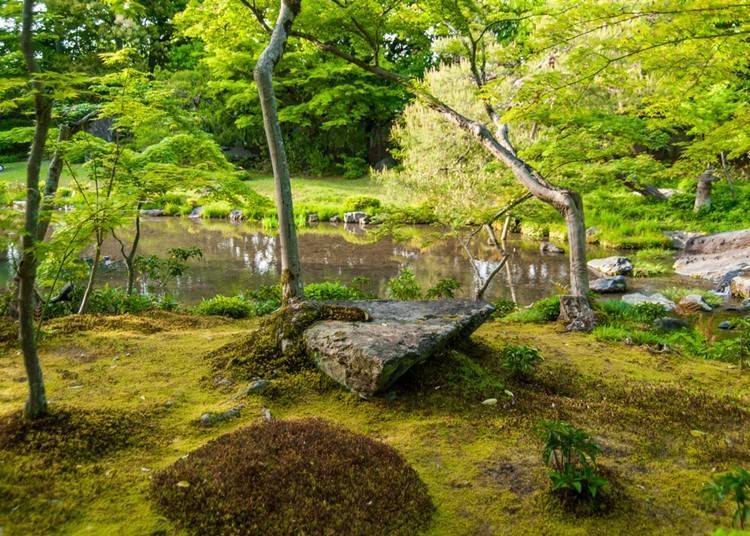
There are various types of Japanese gardens. There are gardens that incorporate background scenery such as distant mountains into the garden landscape, gardens that include ponds for strolling around (strolling pond garden), dry gardens (karesansui), which use rocks and stones to create imagery of flowing water, and tea gardens (chaniwa).
However, in some cases, a dry garden may also act as a strolling garden, or a strolling garden may contain a dry garden within it. Therefore, it isn't always possible to determine a garden's type from its design alone.
Instead, Ms. Yamada of Ueyakato Landscape suggests focusing on the essence of the garden rather than its structure by contemplating the garden's history and how people felt about it in the past.
The history of Japanese gardens dates back to the 6th century Asuka Period. At that time, they mostly functioned as ceremonial spaces.
However, during the Nara and Heian Periods of the 8th and 9th-12th centuries, the aristocrats' power increased, and gardens were built for socializing as open, luxurious spaces with large ponds.
When samurai came to power in the 13th century, dry gardens arose from the concepts of Zen, and later, tea gardens were established as part of tea ceremony culture. Tea gardens were small gardens attached to tea rooms that replicated the calming tranquility of the vast mountains.
During the Tokugawa Shogunate in the 17th-19th centuries, daimyo built magnificent gardens to show off their financial strength and status. The vast, elegant palace gardens in the villa of the Imperial Family also flourished.
In modern times, financial groups and politicians built private villa gardens where they could freely express their interests.
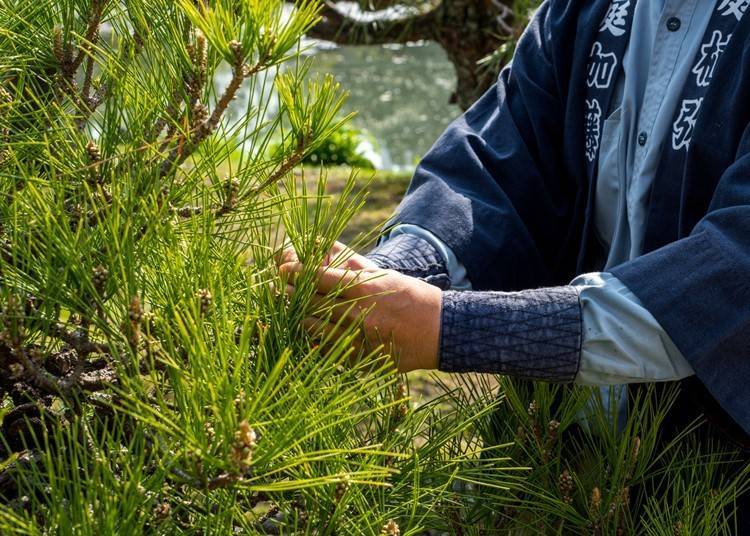
3 Things to know about Japanese gardens
Here are three things to know about Japanese gardens and their history.
Point 1: Natural design over human design.
This concept suggests that no matter how much effort one makes, human design cannot compete with natural design.
When building a Japanese garden, it is important to consider the topography and geology of the site, and use natural materials such as stones and trees. Respect for nature is at the root.
Point 2: The intention of non-intentionality.
Consider the gardener's design methods not as intentional, but intentionally unintentional.
In the Japanese gardens of Kyoto, gardeners take special care to make sure the scenery looks and feels so natural that you forget it was created by human hands at all!
The more natural a garden appears, the greater the gardener's skill in replicating the beauty of nature.
Point 3: The older the garden, the more valuable it is.
In today's consumer society, we often equate newness with value. Gardens, however, are a different story. In the case of Japanese gardens, a newly-created garden is incomplete.
Some say that a garden can only really be seen after 10 years. The older a garden gets, the more aesthetic and historical it becomes. Change that occurs with the passage of time is valuable. Perhaps one of the reasons so many people are fascinated by the mossy garden is because of how it expresses the passage of time.
Tips for viewing design-focused Japanese gardens
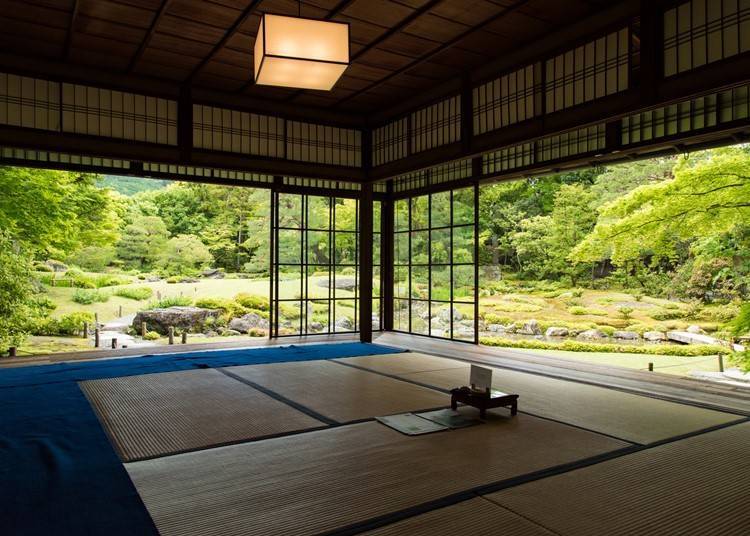
There are two points to consider when admiring a Japanese garden.
(1) The relationship between the landscape and the garden
(2) The relationship between the architecture and the garden
If you can understand these two concepts, you'll understand the garden.
When constructing a garden, it is important to incorporate nature.
First, notice how the design of the garden makes use of the site's terrain. Observe the undulations and slopes of the land and what lies on the other side. If there are mountains nearby, their slopes may become part of the continuous landscape, such as one where water appears to flow right from the mountain.
Also, pay attention to what part of the site the garden is built on. This will help you understand what the gardener wants to show you and how. Kyoto is a basin surrounded by mountains on three sides, so it's relatively easy to draw inferences.
For example, in the villas around eastern Kyoto's Nanzen-ji Temple, most structures are situated on the west side of the site, where you can see the Higashiyama mountains from the garden.
On the other hand, in western parts of Kyoto, such as Arashiyama and Sagano, most structures are placed on the east side, allowing you to see the western mountains from the garden. As you can see, many gardens were built with the intention of seeing the mountains.
Finding the Viewpoint: 5 Famous Kyoto Gardens
The Japanese garden is always built with a viewpoint in mind. When admiring a garden, always look for this viewpoint. Once you find it, you'll surely notice something that you hadn't before!
When looking for the viewpoint, pay attention to places you would stop, such as the corners of garden paths, eye-catching stones, and where you can hear the sound of waterfalls. These are usually great photo spots, too.
Gardens are not composed of a single viewpoint. Anywhere that makes you think “this is the place” is also your own personal viewpoint. The key to enjoying a garden is imagining it as if it were your own.
With these points in mind, we will now introduce five famous Kyoto gardens as recommended by Ms. Yamada.
1. Nanzen-in: The Fresh Green Birthplace of Nanzen-ji Temple
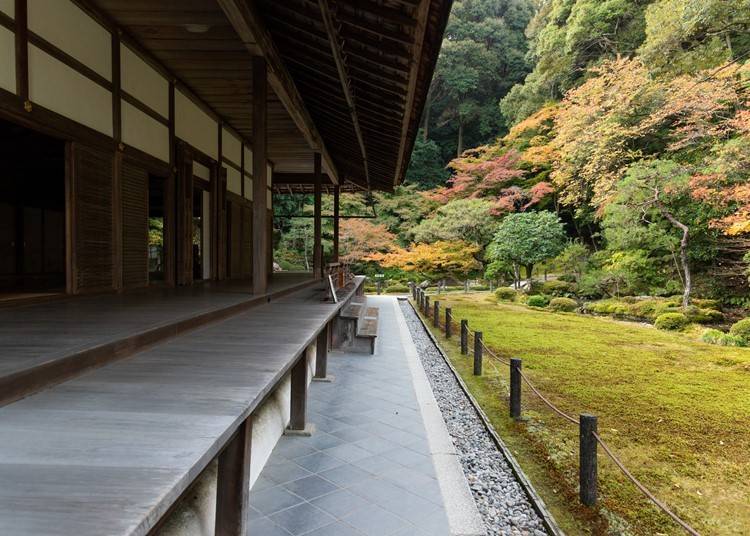
Nanzen-in Temple stands quietly atop the stone steps of Suirokaku, an aqueduct of the Lake Biwa Canal reminiscent of ancient Rome that passes through the precincts of Nanzen-ji Temple.
It was founded as the residence of Emperor Kameyama during the 13th century. Later, the emperor, who practiced Zen Buddhism, turned the residence into a temple, and Nanzen-ji Temple was born.
The garden of Nanzen-in is one of Kyoto's remaining strolling pond gardens, reminiscent of ages past.
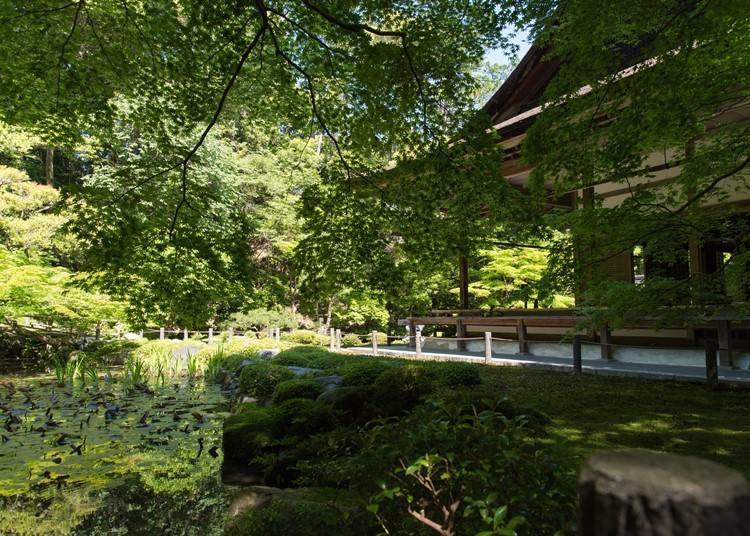
Once you step into the deep forests of this Japanese garden, you'll be enveloped by an air of mystery created by the uneven terrain. It feels like a special place that was reserved for the nobles. The pond, modeled in the shape of a dragon, incorporates the natural terrain of hollowed-out bedrock.
Although the architecture was rebuilt in later times, it retained the qualities of the original garden and its intended viewpoints, creating a wonderful balance between the garden and the architecture.
Unfortunately, while it's meant to be seen from inside, visitors are not allowed in the building. At times like these, imagination is key!
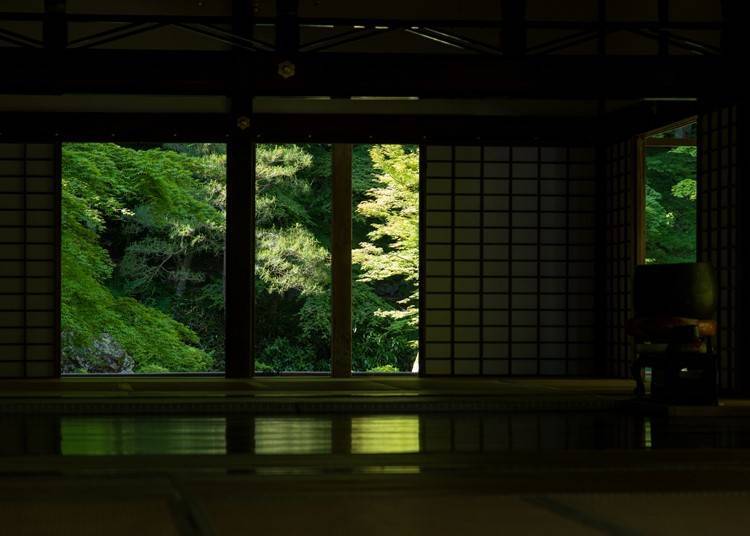
We especially recommend visiting when the leaves are fresh and green. If you visit Nanzen-ji Temple, be sure to check out Nanzen-in as well.
-
Nanzen-in南禅院
- Address 86 Furoyamacho, Nanzen-ji, Sakyo-ku, Kyoto, 606-8435
・TEL: 075-771-0365 (Nanzen-ji Temple)
・Hours: March-November 8:40 a.m. - 5:00 p.m. (reception ends 4:40 p.m.), December-February 8:40 a.m. - 4:30 p.m. (reception ends 4:10PM)
・Admission:
Adults: 400 yen
High school students: 350 yen
Elementary/junior high students: 250 yen
・Closed: Open daily (closed to general visits December 28-31), visits suspended on April 6, 2022
*Nanzen-ji Hojo will be closed April 5-6, 2022.
・Parking: Yes (11 buses, 12 cars)
2. Ryoanji: A World-Famous Japanese Dry Garden
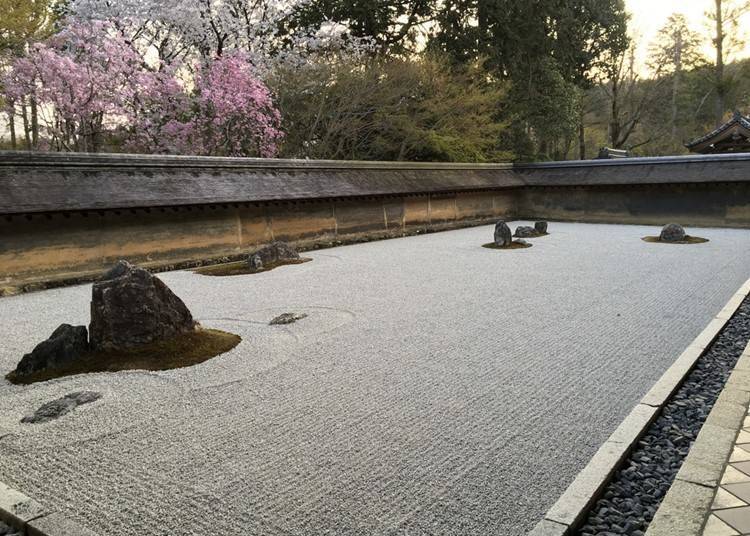
Built in 1450, Ryoanji is a Zen temple and registered World Cultural Heritage Site. This overwhelmingly beautiful, world-famous stone garden is a karesansui garden consisting of 15 large and small stones arranged on pure white sand. The fact that the garden's creator remains unknown only adds to the garden's mystery and charm.
This new style of dry garden was born in an attempt to express something more ideological by an emerging samurai culture with Zen ideas.

Most of the viewpoints are built to be observed only from inside the building, rather than by walking around all sides of the garden. Even though the stones and sand in the garden remain still, you can practically feel the movement and infinite expanse of the scenery.
Though stones and moss are all that stand before you, there's much more to see than mere stones and moss. Try to understand what this means. Each viewer may find their own answer within their own hearts.

When visiting, we recommend going at a time when you can sit for about 30 minutes facing the garden. Sitting calmly for 30 minutes allows you to feel the subtle changes of the light, the wind, and the color of the sky.
Quietly contemplate the garden, simple yet deep, as you sharpen your five senses.
-

-
Address
13, Ryoan-ji Goryounoshitacho, Ukyo-ku, Kyoto-shi, Kyoto, 616-8001
View Map -
Nearest Station
Ryoanji Station (Keifuku Dentetsu-kitano Line)
7 minutes on foot
- Phone Number 075-463-2216
-
Address
13, Ryoan-ji Goryounoshitacho, Ukyo-ku, Kyoto-shi, Kyoto, 616-8001
3. Katsura Imperial Villa: A Collection of the Best Imperial Courts
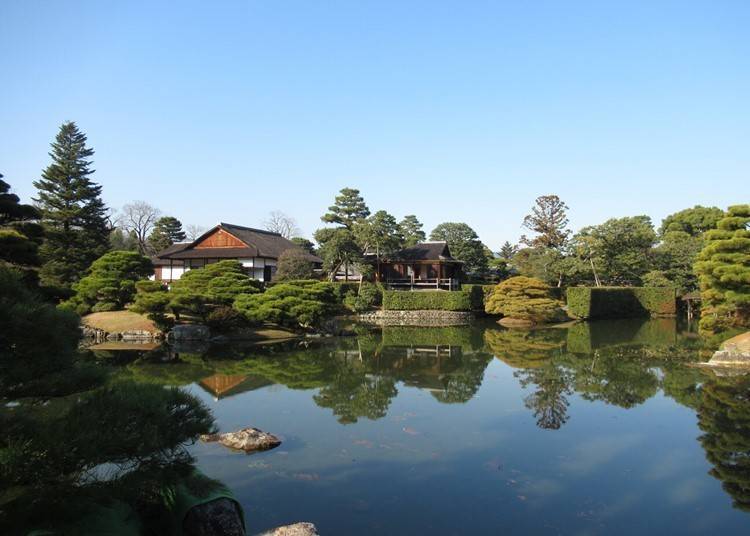
The Katsura Imperial Villa is a villa garden of the imperial family built in the Edo Period (17th century) in Katsura, Nishikyo. This beautiful garden, situated on a vast site of about 69,400 square meters, was developed through the combination of overwhelming financial and political power, and stunning architecture as seen in the drawing-room and the tea room.
The pond in the center of the garden consists of water from the Katsura River since its first construction and has five islands, big and small. As a strolling pond garden, you can walk around the pond, or take a boat to visit the garden.
Its current state has been almost perfectly preserved since the time of its foundation, allowing you to experience the splendor of the imperial court culture that has fascinated people through literature and architecture.

Advanced reservations are required to visit the Katsura Imperial Villa. As the guide takes you through the sightseeing course, you'll imagine scenes from ages past of people visiting the palace, reading poetry from a boat, watching the moon, and sipping on tea.
Don't simply admire the scenery and architecture. As you walk around, put yourself in the shoes of those long-ago visitors. Feel what they felt, and stroll the paths they might have strolled. Imagine yourself enjoying one of their tea ceremonies. There's much more to see than what stands before you!
-
KATSURA IMPERIAL VILLA桂離宮
- Address Katsuramisono, Nishikyo-ku, Kyoto, 615-8014
・TEL: 075-211-1215 (Imperial Household Agency Kyoto Office, closed Mondays/ following day if national holiday)
・Hours: 9:00 a.m., 10:00 a.m., 11:00 a.m., 12:00 p.m., 1:00 p.m., 2:00 p.m., 3:00 p.m.
*Advance application required. Same-day application possible if vacancies available. https://sankan.kunaicho.go.jp/guide/katsurarikyu.html
・Admission: Adults: 1000 yen,
Junior high/high school students: Free
*Visits open to junior high students and older
・Closed: Mondays (following day if national holiday)
・Parking: Yes (30 cars)
*Multilingual pamphlets available (English / French / Chinese / Korean)
*Free audio guide rentals (English / French / Spanish / Chinese / Korean)
4. Shosei-en: A Spacious Garden Near Kyoto Station
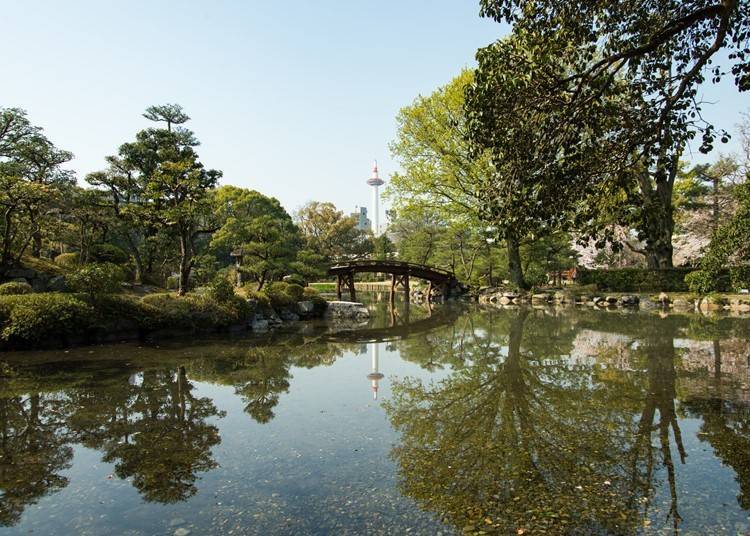
Shosei-en Garden is close to JR Kyoto Station, only ten minutes on foot. It's a great place to visit if you've finished sightseeing early and have time to spare before the next Shinkansen.
The photo spot, and current viewpoint of the long-established garden, features Kyoto Tower over the Japanese garden, a scene that brings together the past and present of Kyoto.
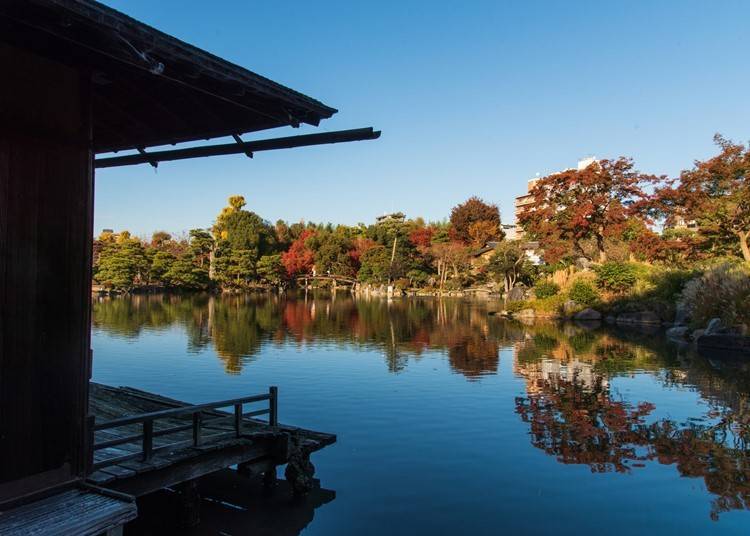
Shosei-en Garden is located in the precincts of Higashi Honganji Temple. It began with the construction of the strolling pond garden in 1641 on land donated by Tokugawa Iemitsu, the third shogun of the Edo Shogunate.
Structures are scattered around the large pond, each with its own stunning view, collectively known as the '13 Views of Shosei-en Garden'.
Also, pay attention to the beauty of the architecture. Rebuilt after a major fire during the Kinmon Incident of 1864, the current structures blend perfectly well with the garden. The impression it conveys now is the same since its first construction, imparting to us the deep history the garden has inherited.
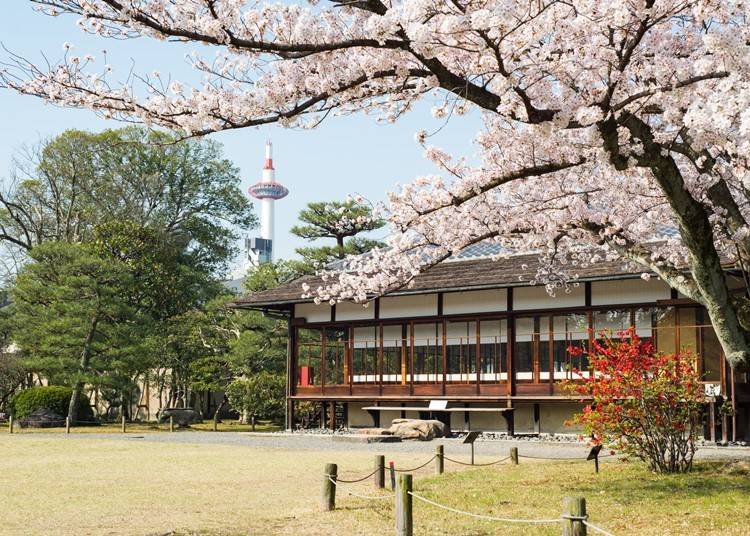
-

-
Address
Higashitamamizucho, Shimojuzuyamachi-dori Ainomachi Higashi-iru, Shimogyo-ku, Kyoto-shi, Kyoto, 600-8190
View Map -
Nearest Station
Kyoto Station (JR Tokaido Line / JR Biwako Line / JR Tokaido Shinkansen / JR Kyoto Line / JR Sagano Line / JR San-in Line / JR Nara Line / Karasuma Line / Kintetsu-kyoto Line)
6 minutes on foot
- Phone Number 075-371-9210
-
Address
Higashitamamizucho, Shimojuzuyamachi-dori Ainomachi Higashi-iru, Shimogyo-ku, Kyoto-shi, Kyoto, 600-8190
5. Murin-an: A Masterpiece of a Modern Japanese Garden
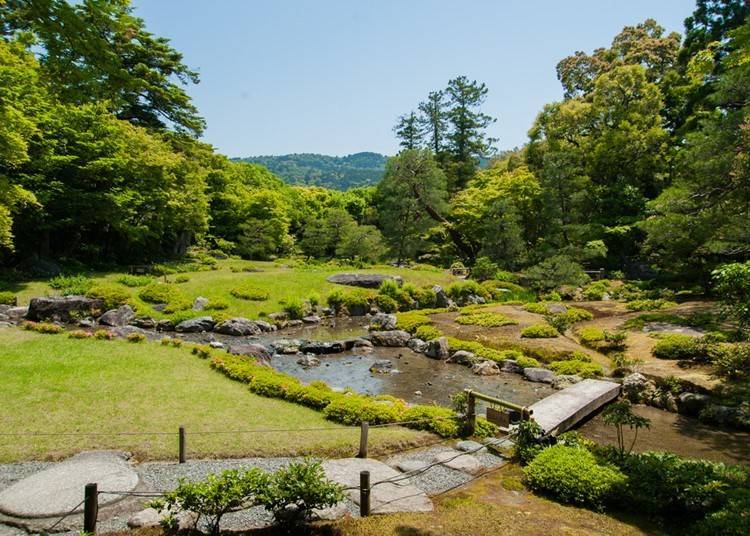
Murin-an, located at the foot of the Higashiyama mountains and only five minutes on foot from Nanzen-ji Temple, was built in 1896 as a villa of Aritomo Yamagata, a politician who served as prime minister.
Situated on the west side of a site stretching from east to west, it consists of the main building, a Western-style building, and a tea room, as well as the garden from which you can see a stunning view of the Higashiyama mountains.
Murin-an also has a variety of rhythmic water flows throughout the garden thanks to the rich water sources made possible by the Lake Biwa Canal, completed in 1890 to transport water from Lake Biwa to Kyoto.
Murin-an encompasses a new kind of garden view that is both naturalistic and dynamic, using the mountain village landscape or streams themselves as part of the scenery, unlike conventional gardens that use ponds and rocks to represent seas and islands. This is why it is said to be a 'pioneer of the modern Japanese garden’.
Many influential people in the political and business world competed for status by building villa gardens that incorporated the scenery of Higashiyama and the water of the Lake Biwa Canal. Of these, Murin-an was the first to be completed.
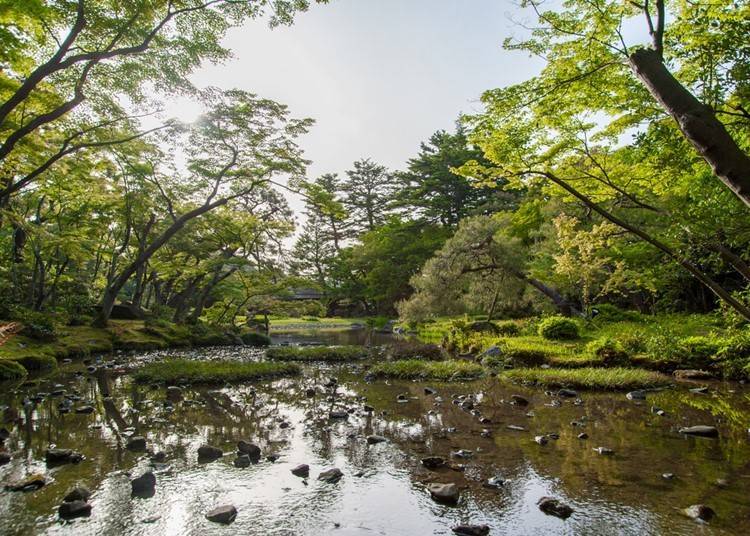
Murin-an is a bright, open grassy area that echoes with the comforting sound of flowing water. Relax at the popular garden cafe, and take in the babbling of the water from the Lake Biwa Canal and the chirping of birds.
As you sip a cup of tea, admire the extensive garden before you, the same garden that Aritomo Yamagata enjoyed, as if it were your own.
-

-
Address
31, Nanzenjikusagawacho, Sakyo-ku, Kyoto-shi, Kyoto, 606-8437
View Map -
Nearest Station
Keage Station (Tozai Line)
6 minutes on foot
- Phone Number 075-771-3909
-
Address
31, Nanzenjikusagawacho, Sakyo-ku, Kyoto-shi, Kyoto, 606-8437
Japanese gardens manage to condense the beauty of Japan into their scenery. Gazing upon them is mysteriously calming and healing. Many of Kyoto's gorgeous gardens still retain the deep history and culture of Japan.
Next time you visit Kyoto, take a leisurely stroll through its gardens and remember all the garden-viewing tips you learned here today.
Information in article as of March 2022. Please see official websites for latest information.
Translated by Krys Suzuki
Kiko Matsuda, Keiko Kimura, Risa Tsushi, and a team of female writers familiar with Kansai. We love eating, drinking and traveling! We share fun information based on our experiences.
*Prices and options mentioned are subject to change.
*Unless stated otherwise, all prices include tax.
Popular Tours & Activitiess
Recommended places for you
-

Jukuseiniku-to Namamottsuarera Nikubaru Italian Nikutaria Sannomiya
Izakaya
Kobe, Sannomiya, Kitano
-

Todai-ji Temple
Temples
Nara, Ikoma, Tenri
-
Goods

Yoshida Gennojo-Roho Kyoto Buddhist Altars
Gift Shops
Nijo Castle, Kyoto Imperial Palace
-

ISHIDAYA Hanare
Yakiniku
Kobe, Sannomiya, Kitano
-

Kanzenkoshitsuyakinikutabehodai Gyugyu Paradise Sannomiya
Yakiniku
Kobe, Sannomiya, Kitano
-

Kambei Sannomiyahonten
Yakiniku
Kobe, Sannomiya, Kitano
-

New Way to Reach Koyasan! Ride Nankai's 'GRAN Tenku' for a Heavenly Journey
by: Guest Contributor
-
Ad

Discover Timeless Beauty: Kimono-en, a Web Magazine Exploring the Spirit of Kimono
-

Everything You Need to Know About teamLab Biovortex Kyoto (2025 Insider Guide)
by: Wemmy Chau
-

Kyoto's Hidden Treasures Open This Winter! Enjoy Exclusive Access to 15 Rare Cultural Sites (Jan-Mar 2026)
by: Guest Contributor
-

A First Look at NEMU RESORT’s 2026 Grand Renewal in Ise-Shima: A Resort Shaped by Village, Sea, and Forest
by: Guest Contributor
-
Ad

Experiencing Manga as Culture, Not Just Reading It: Expo 2025 with Rumiko Takahashi
Inspiration for Accommodations
-

Spacious Family Hotel in Namba: 20 Comfortable Stays for Family Fun
-

Charming Hotels to Enjoy the Spectacular Views of Arashiyama's Autumn Leaves from Your Room
-

Experience Stunning Views of Osaka Castle from Private Spaces: Top Hotels Near Osaka Castle
-

Recommended by Visitors! Arashiyama's Best-Rated Hotels
-

Family-Friendly Universal Studios Japan Hotel with Excellent Access
-

Enjoy a Comfortable Stay in Osaka! 10 Hotels with Convenient Airport Shuttle Services
-

Top 10 Recommended Hotels Near Namba Station with Great Access
-

Enjoy Night Views from Your Room! Recommended Hotels in Namba Area
-

Secrets to Shopping in Japan: Guide to Annual Sales in Japan & Where to Shop
by: Miyu Shimada
-

Top 3 Restaurants: Best Sushi in Dotonbori According to a Local Food Critic
-

(Video) Walking Tour along Narita Omotesando - Quaint Historical Village near Narita Airport!
by: Victor Gonzalez
-

10 Important Japanese Phrases to Know Before You Enter a Japanese Convenience Store!
by: Teni Wada
-

Visiting Tsutenkaku Tower: Osaka's Retro Icon in the Heart of Shinsekai
by: Guest Contributor
-

Osaka Koreatown: In Search of the Best Eats in the Korean Roots of Osaka's Tsuruhashi Market
- #best gourmet Osaka
- #things to do Osaka
- #what to do in kyoto
- #what to bring to japan
- #best gourmet Kyoto
- #new years in Osaka
- #what to buy in nanba
- #Visiting Osaka
- #onsen tattoo friendly arima
- #daiso
- #Visiting Kyoto
- #best japanese soft drinks
- #japanese fashion culture
- #japanese convenience store snacks
- #japanese nail trends















